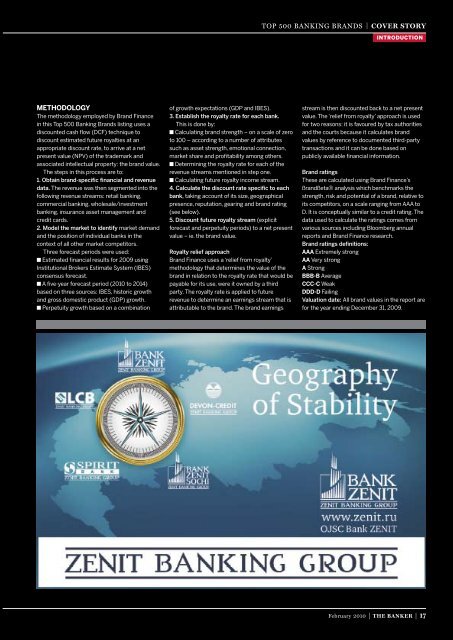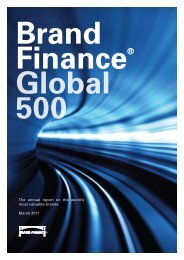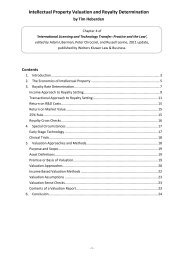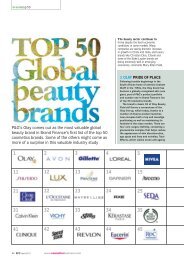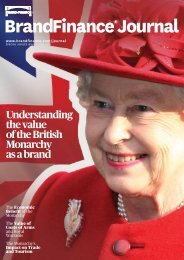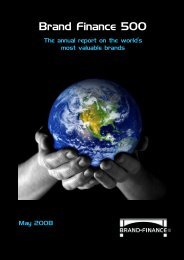Create successful ePaper yourself
Turn your PDF publications into a flip-book with our unique Google optimized e-Paper software.
METHODOLOGY<br />
The methodology employed by <strong>Brand</strong> <strong>Finance</strong><br />
in this Top 500 Banking <strong>Brand</strong>s listing uses a<br />
discounted cash flow (DCF) technique to<br />
discount estimated future royalties at an<br />
appropriate discount rate, to arrive at a net<br />
present value (NPV) of the trademark and<br />
associated intellectual property: the brand value.<br />
The steps in this process are to:<br />
1. Obtain brand-specific financial and revenue<br />
data. The revenue was then segmented into the<br />
following revenue streams: retail banking,<br />
commercial banking, wholesale/investment<br />
banking, insurance asset management and<br />
credit cards.<br />
2. Model the market to identify market demand<br />
and the position of individual banks in the<br />
context of all other market competitors.<br />
Three forecast periods were used:<br />
■ Estimated financial results for 2009 using<br />
Institutional Brokers Estimate System (IBES)<br />
consensus forecast.<br />
■ A five-year forecast period (2010 to 2014)<br />
based on three sources: IBES, historic growth<br />
and gross domestic product (GDP) growth.<br />
■ Perpetuity growth based on a combination<br />
of growth expectations (GDP and IBES).<br />
3. Establish the royalty rate for each bank.<br />
This is done by:<br />
■ Calculating brand strength – on a scale of zero<br />
to 100 – according to a number of attributes<br />
such as asset strength, emotional connection,<br />
market share and profitability among others.<br />
■ Determining the royalty rate for each of the<br />
revenue streams mentioned in step one.<br />
■ Calculating future royalty income stream.<br />
4. Calculate the discount rate specific to each<br />
bank, taking account of its size, geographical<br />
presence, reputation, gearing and brand rating<br />
(see below).<br />
5. Discount future royalty stream (explicit<br />
forecast and perpetuity periods) to a net present<br />
value – ie. the brand value.<br />
Royalty relief approach<br />
<strong>Brand</strong> <strong>Finance</strong> uses a ‘relief from royalty’<br />
methodology that determines the value of the<br />
brand in relation to the royalty rate that would be<br />
payable for its use, were it owned by a third<br />
party. The royalty rate is applied to future<br />
revenue to determine an earnings stream that is<br />
attributable to the brand. The brand earnings<br />
TOp 500 BANKING BrANDS | cOver sTOry<br />
introduction<br />
stream is then discounted back to a net present<br />
value. The ‘relief from royalty’ approach is used<br />
for two reasons: it is favoured by tax authorities<br />
and the courts because it calculates brand<br />
values by reference to documented third-party<br />
transactions and it can be done based on<br />
publicly available financial information.<br />
<strong>Brand</strong> ratings<br />
These are calculated using <strong>Brand</strong> <strong>Finance</strong>’s<br />
ßrandßeta® analysis which benchmarks the<br />
strength, risk and potential of a brand, relative to<br />
its competitors, on a scale ranging from AAA to<br />
D. It is conceptually similar to a credit rating. The<br />
data used to calculate the ratings comes from<br />
various sources including Bloomberg annual<br />
reports and <strong>Brand</strong> <strong>Finance</strong> research.<br />
<strong>Brand</strong> ratings definitions:<br />
AAA Extremely strong<br />
AA Very strong<br />
A Strong<br />
BBB-B Average<br />
CCC-C Weak<br />
DDD-D Failing<br />
Valuation date: All brand values in the report are<br />
for the year ending December 31, 2009.<br />
February 2010 | The Banker | 17


